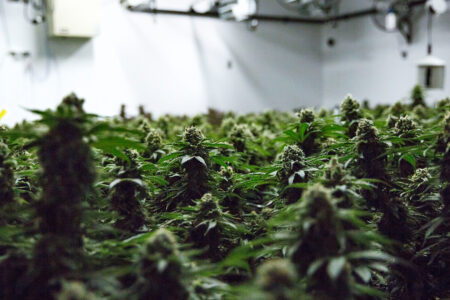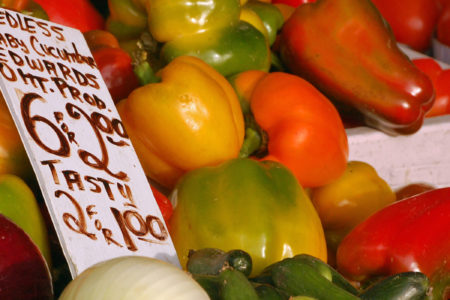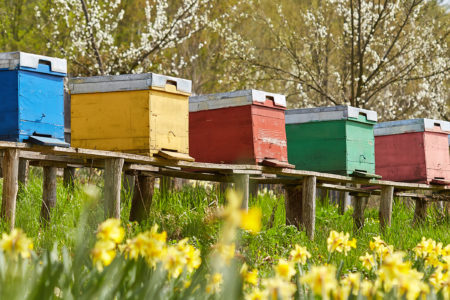
Till the land. Seed annual crop. Fertilize and irrigate. Spray for weeds and pests. Harvest. Repeat. This simple process, give or take a few steps, describes a considerable (and growing) portion of contemporary agriculture in Canada. More than half of the nation’s farmland is now dedicated to the production of crops that are produced on large tracts of land with highly advanced industrial equipment (like computerized tractors with proprietary software). Because of shifting global economic forces in the last decade, including increasing grain prices and rising demand in Asia, this type of agriculture has driven considerable growth in Canada’s GDP, significantly increased export volumes, and generated profits for large farms and agri-food corporations. Industrial livestock, fattened up by these crops, have contributed to Canada’s growing agri-food and seafood export revenues.
Industrial agriculture’s strong growth is exactly why policy-makers want to intensify it in the coming years, increasing agri-food exports, unrolling new technologies and automation in the sector, and doing a better job of capturing value from domestic processing. By embarking on this “new industrial revolution” in agriculture, proponents argue, Canada could become a “trusted global leader in safe, nutritious and sustainable food for the 21st century.” This sunny narrative depicts Canada playing a key role in feeding the world’s growing population, while growing its economy and protecting its environment.
Despite affording evident benefits to Canada’s status, the agri-food sector’s neo-industrialization is not all glamorous. Specifically, there is good reason to reflect critically on claims about the system’s long-term sustainability. There are social, economic and environmental challenges to the neo-industrialization of agriculture, and I argue that Canada ought not to put all its eggs in the neo-industrial basket, so to speak. Rather, there is much to be gained from also betting on small-scale “agro-ecological” farms, if the goal is to make Canada’s agri-food sector more sustainable.
First, let us consider some social and economic features of neo-industrialization (these are, after all, two key pillars of sustainability, along with environmental concerns). To start off, it is important here to make a distinction between large industrial farms, which cater to global markets, and small and mid-sized farms, which primarily aim to contribute to domestic food supply. Arguably, it is the former group that is truly benefiting from the neo-industrialization trend, while the rest are struggling to get by, if not disappearing altogether. In Canada, there are less than 10,000 farms with gross revenues over $1,000,000, while there are more than 200,000 farms with annual revenues under that benchmark.
Not surprisingly, the top- 5-percent-earning farms produce over half the nation’s agricultural revenue. While the total number of farms in Canada has declined since 1941 (by a quarter between 1990 and 2011), the number of “million-dollar farms” has actually grown in recent years. The average size of a Canadian farm has grown too (this trend is far more pronounced in the prairies), fuelled not only by urbanization (and sprawling development), but also by the corporatization of agriculture. The percentage of incorporated farms grew from about 4 percent in 1981 to nearly 20 percent in 2011 (and yes, the largest, highest-earning farms are more likely to be incorporated).
Since the early 1990s, the average farm operator is seven years older; is more likely to be renting the land they work with; and is working fewer hours on the farm (which suggests a greater need for supplemental off-farm income, yet the proportion of farm operators finding work off the farm has also declined since 1990). As well, the number of agricultural workers has steadily declined in across the country (a trend that started over a century ago). Finally, while the nation’s outstanding farm debts in 1990 stood at around $23.6 billion, the figure has climbed precipitously to $91.7 billion in 2015 – perhaps not surprising when one considers that a new combine can easily cost over half a million dollars.
We must ask ourselves whether these social and economic trends, partly driven by the steady industrialization of the agricultural sector, are sustainable? Will the predicted prosperity in Canadian agriculture be shared by all producers or just the richest few? How long can effects such as the hollowing out of rural areas, the decline in agricultural work hours and the aging of the agricultural population be sustained? As the National Farmers Union (NFU) recently concluded, “farmer autonomy and local control of land and production, which are the foundations of food sovereignty, are threatened by excessive farm debt loads, input financing, the conversion of farmland to non-farm uses. . .and by land grabbing,” among other threats. It’s not clear this situation is sustainable for the majority of Canada’s farmers and agricultural communities.
Industrialization has reduced the amount of inputs (feed, fertilizers, water) and the harmful outputs (greenhouse gases, waste and pollutants) per unit of product, but industrial landscapes require high levels of inputs and generate unwanted outputs.
We must also think critically about the third pillar of sustainability – the environment. Proponents of neo-industrialization argue that technological innovation and economies of scale will yield more efficient equipment and practices that will have less impact on the environment. This argument, which is centred on the benefits of “intensity” (the idea that the industrial model’s larger scale of production allows it to yield more product per unit of environmental damage), starts to unravel when we look at the environment holistically. Put differently, while industrialization has demonstrably reduced the amount of inputs required (feed, fertilizers, water) and the harmful outputs (greenhouse gases, waste and pollutants) per unit of product, the fact remains that industrial landscapes require high levels of inputs and generate unwanted outputs.
Regardless of how efficient the practice may be at producing food, industrial monocropping — invented after the Second World War and facilitated by the exponential growth in petroleum production — is in many ways an unmitigated environmental disaster. In terms of biodiversity alone, large croplands have a devastating impact, obliterating large areas of wildlife habitat and migration corridors, drastically narrowing the genetic pool of food crops, and depending on harmful herbicides and pesticides that impact soil biota, flora and fauna. In such settings it becomes necessary to apply chemical pesticides to protect crops from wild herbivores, birds and insects, and as the UN notes, global pesticide use has had “catastrophic impacts on the environment, human health and society as a whole.” In terms of agricultural soils, severe harm has been brought about by industrial farming practices, which rely on synthetic fertilizers and other chemical inputs, and which often leave soils bare, leading to problems like soil erosion, the loss of soil organic carbon (SOC), nitrogen depletion, and salinization.
Perhaps one saving grace for Canada’s mega-crop producers is the growing acceptance of no-till and other low-disturbance practices since the 1980s, which has significantly reduced the risk of soil erosion, loss of SOC, and salinization. However, while no-till practices are helping to minimize the ecological footprint of industrial agriculture (and should be a requirement), a study by the Prairie Farm Rehabilitation Administration in Saskatchewan highlights a range of structural challenges that constrain industrial farmers from fully adopting these practices, and these constraints themselves are exacerbated by climate change.
Taking a step back, there is an inherent contradiction between the processes and structures embedded in industrial agriculture and the types of social, economic, and environmental remediation it claims to carry out. Despite its apparent macro-benefits, there is a case to be made that the neo-industrial model is structured upon a fundamentally unsustainable cycle that benefits only a small portion of farmers; locks many others into endless debt; degrades agricultural soils in the long-term; leads to biodiversity loss; contaminates water bodies; exacerbates climate change; erodes domestic food security; and catalyzes the decline of family farms, traditional agricultural knowledge and rural communities.
If sustainability in the agri-food system is what is sought, perhaps Canada should consider a two-tiered policy — one that privileges agro-ecological farming as well as mainstream agriculture. In its approach, agro-ecology is completely different from mainstream agriculture. It is founded on ecological principles such as the regeneration of landscapes, habitats and natural cycles; the reduction of external and synthetic inputs (which reduces the production footprint and gives farmers more autonomy); and a commitment to improving communities through access to healthy, diverse, local food. While it comes in many shapes and forms (from restorative permaculture to urban farming), agro-ecological practices are catching on in Canada and abroad, and are supported by a range of organizations and institutions (like the NFU, USC Canada, Food Secure Canada, even the UN Human Rights Council) as an essential response to the social, economic and ecological challenges brought about by decades of industrialization.
While neo-industrialization is indeed likely to dominate the future of Canadian farming, we must ensure that other, more sustainable approaches to Canadian agriculture continue to thrive alongside it. The agro-ecology movement is admittedly just a drop in the agricultural sector’s bucket. Nevertheless, its careful thought about treating agricultural landscapes as natural ecosystems, production of food for local communities and protecting farmer livelihoods are things we cannot let flounder in this age of social, economic and environmental uncertainty.
This article is part of the Canadian Agriculture at the Cutting Edge special feature.
Photo: Containers of fresh berries from Quebec for sale at the Marche Jean Talon farmers market in Montreal. Shutterstock/EQRoy
Do you have something to say about the article you just read? Be part of the Policy Options discussion, and send in your own submission. Here is a link on how to do it. | Souhaitez-vous réagir à cet article ? Joignez-vous aux débats d’Options politiques et soumettez-nous votre texte en suivant ces directives.







